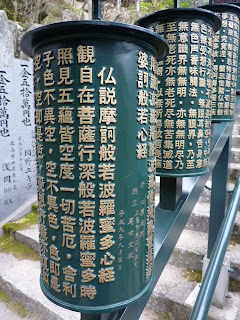After Himeji, it's back on the bullet train to Hiroshima where we wander round the Peace Park. This is centred around a domed building which somehow largely survived the explosion of Little Boy in 1945, when most of the surrounding area was flattened, and they have determined to preserve the building in this state in perpetuity (many other damaged buildings were demolished and built over in the years following the war). Its now-skeletal dome is an effective symbol.
A lot of this area is set up to be an anti-nuclear-weapons demonstration by showing the effects of the bomb. It's generally tasteful and effective. As well as their efforts to document everyone who died in the bomb here, almost every imaginable group seems to get their own monument here - children, students, Koreans brought here as forced labour, etc.
We also walked past the castle - flattened by the bomb but entirely rebuilt - and went to a couple of museums. My favourite exhibit was by a guy called Yoshimura Yoshio - google his newspaper self-portraits (I haven't had chance to do this) - individually they're a fun curiosity but a huge wall of them was very impressive (especially the large ones where he has hand-written every word of text).
Then we took a ferry to the beautiful island of Miyajima, which was a real highlight. It is famous for its large red torii gate which rises up out of the sea just off shore, and the similarly red Itsukushima Shrine, which sits on stilts by the shore. The torii is beautiful when lit up at night and (presumably) on sunny days.
We got here in the evening and stayed in a traditional Japanese ryokan where we were the only guests. Not cheap but a lovely place (with deer wandering past outside) and an interesting semi-authentic experience (complete with ticking-off from the mama-san for not wanting seafood on my menu - "On Miyajima, everything is fishes!").
The nearby Daishoin Temple is a beautiful complex of buildings nearby, apparently less visited. This is a don't-miss too, with many treasures in terms of style, detail and sheer hard work - such as a room whose roof is covered with lanterns, another containing hundreds if not thousands of six-inch-tall carved wooden figures, or just the beautifully cast and painted metal cylinders on the side of staircases for the devout to run their hands over and spin.
We finished by taking a cable-car up Mt Misen and walking the 1-hour circuit at the top, with a few shrines and natural curios. The views would be stunning on a clear day - ours was a bit misty - but still a nice hike.
Next: Kyoto!
Subscribe to:
Post Comments (Atom)






No comments:
Post a Comment